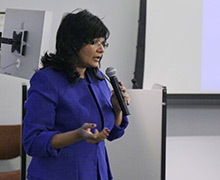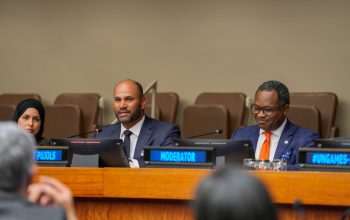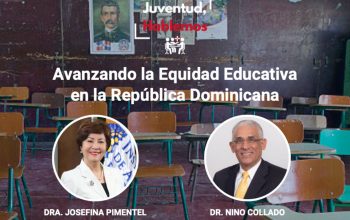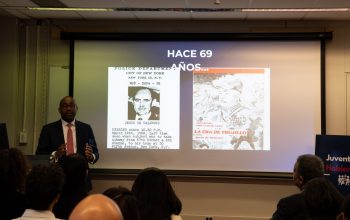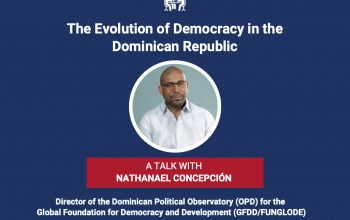news
CIC-Funglode Presented the Book “Análisis de la Programación de la Televisión Abierta Dominicana” in CUNY
June 23, 2016
The Communications Research Center (CIC, for its acronym in Spanish) of Fundación Global Democracia y Desarrollo (Funglode) presented on Thursday June 23 in New York the book Análisis de la Programación de la Televisión Abierta Dominicana (Analysis of Dominican Broadcast Television Programing).
At the event, the director of the CIC-Funglode and general coordinator of the book, Elina María Cruz, shared with the audience the
process of investigation that resulted in the publication, with the analysis of the programming on 17 channels of the bands VHF and UHF and 567 programs.
The activity took place at CUNY’s Graduate School of Journalism, and was attended by Yamile Eusebio, director of Global Foundation for Democracy and Development (GFDD) New York office. This activity is part of the collaborative work carried out by CUNY and GFDD/Funglode in recent years.
Eusebio explained that “the presentation of this publication offers to all its readers very timely information that will allow them to make their own assessments on what is happening in the Dominican television. Without a doubt, programming for children is what draws the most attention since there isn’t an appropriate offer for this population in our country.”
The study consisted of the analysis of programming on seven
channels of VHF and ten of UHF to determine the basic characteristics of the spaces that make up the grid of Dominican television. It was developed with the collaboration of Professor Josep Lluís Micó, as part of the working arrangements with the Faculty of Communication and International Relations Blanquerna of the Ramon Llull University of Barcelona.
There were analyzed 567 programs part of the regular programming of the 17 channels that constituted the study sample:
Amé 47, Antena Latina, CERTV, Color Visión, Coral 39, Digital 15, CDN, RNN, Súper Canal, Teleantillas, Telecentro, Telefuturo, Telemicro, Teleradio América, Telesistema, Teleuniverso and Televida.
From the data collected, the analysts evaluated the characteristics of the grid, taking into account different aspects: the year when the programs were launched; presence and use of the web and social media to broaden the audience; and country of origin, genres, and formats of
the productions.
The spaces that occupy children’s content, news and advertising, among others, are part of the publication. They also reveal relevant information about the talents in the programs, depending on their gender and professional profiles, to demonstrate the correlation between men and women.
The content also includes the themes "The digital gap of Dominican television", "Entertainment programs on
Dominican television", "The informative programming" and "Religious programs".
The book includes the research conducted by the CIC-Funglode with Cruz, Jenny Almonte, Edel Aguasanta and Danielis Fermin.
In the second part, journalists Pedro Caba and Melvin Peña; the lawyer specializing in audiovisual regulation, Gabriela Beltre; and writer Elvira Dulce de los Santos, reflect on the diagnosis derived from the
research and the many questions that television products watched by Dominicans generate.
Caba refers to "Public media"; Peña to "Dominican television of the XXI Century" and Beltre to "The new audiovisual order". De los Santos shares his vision on "The challenge of producing for the young audience."
Taking advantage of CUNY’s stage during the event it was highlighted the
transmission of regular Dominican programs on US cable as a result of the demand from Dominicans living in the nation.
About CIC-Funglode
The Communications Research Center is an initiative of the Fundación Global Democracia y Desarrollo (Funglode). It was created in 2006 with the aim to produce research on the communications industry in the Dominican Republic to become tools for generating communication policies.
It is
the fourth publication that is derived from an equal number of investigations carried out by the CIC-Funglode. The first is the Dominican Bibliography of Communication, put online in 2008, followed by the Libro blanco del periodismo dominicano in 2011, and Treatment of HIV / AIDS in the written media: Diario Libre, El Caribe, The Day, Today, Listin Diario and El Nacional, in 2012.

